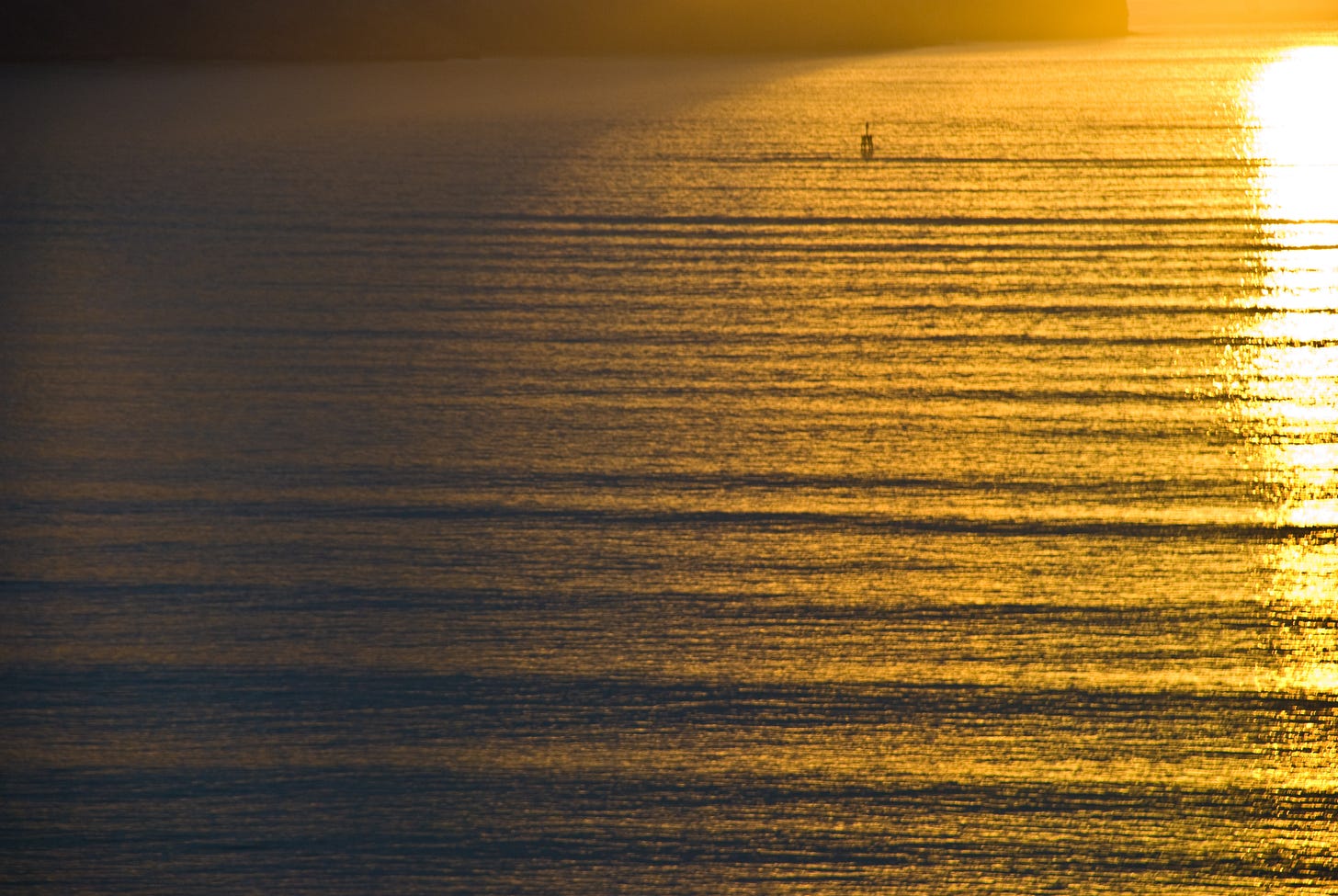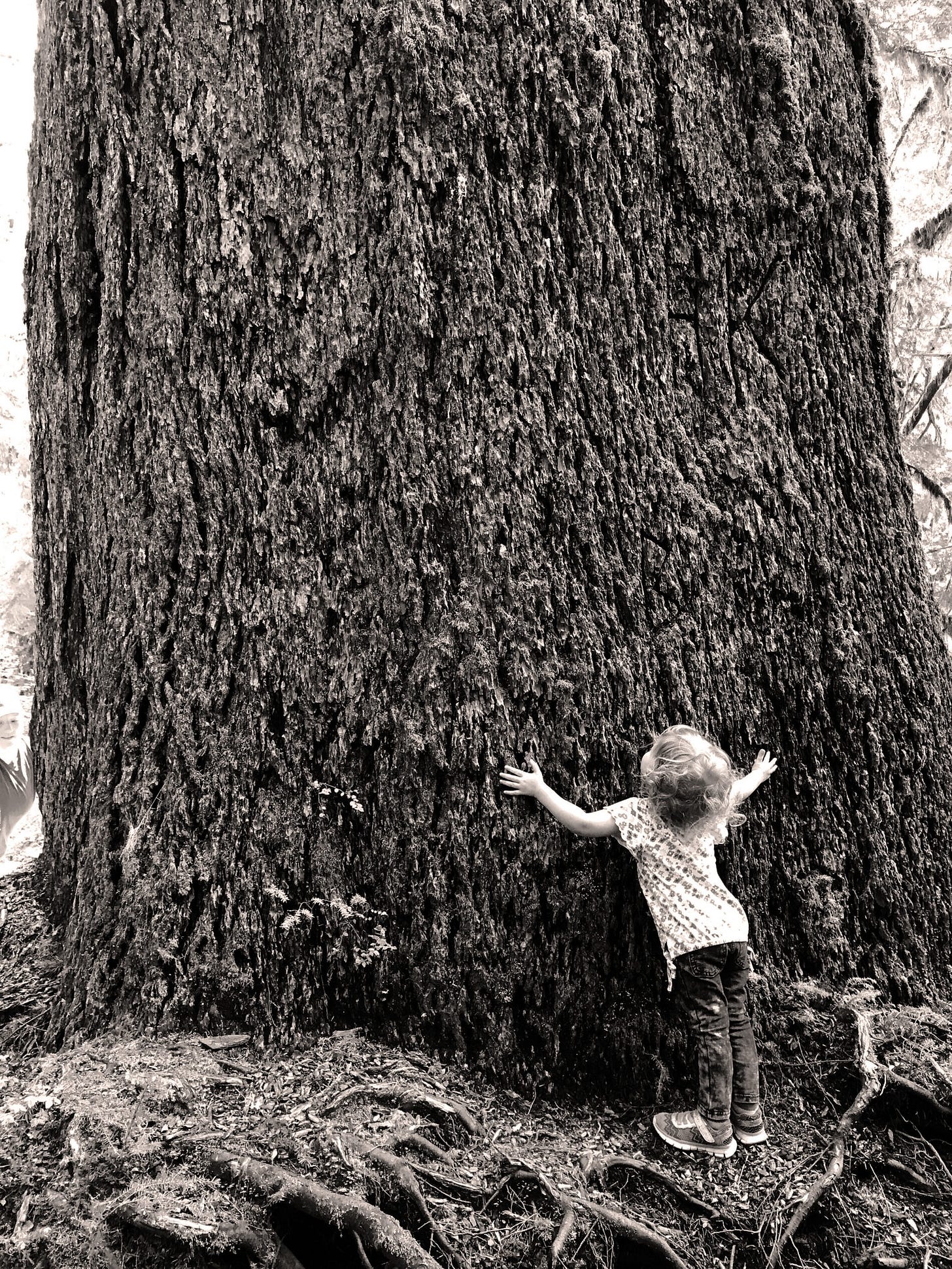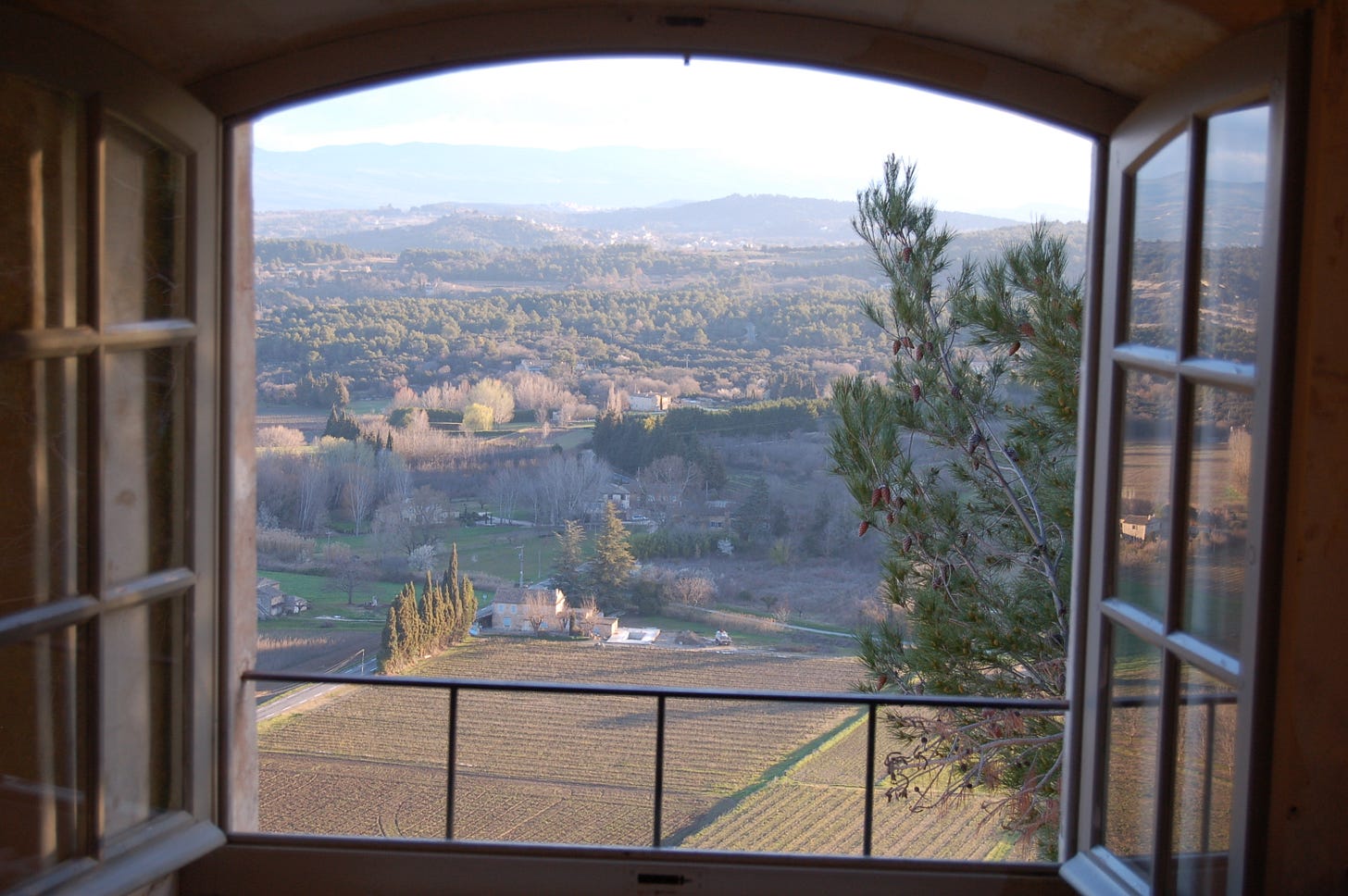Waves and the Fabric of Life
7/14/22 – Shortsightedness, farsightedness, and the Anthropocene
Hello everyone:
As always, please remember to scroll past the end of the post to read this week’s curated Anthropocene news.
Now on to this week’s writing:
I had a fun conversation recently with my friend Josh about the patterns of physical energy all around us that we are either blind to or, if we’re lucky, we occasionally catch glimpses of. He described seeing swirls at the water’s surface caused by a fish and then thinking about the multitude of forces swirling through the already restless sea in the wake of billions of fish. We talked about the wind made visible as it rushes from tree to tree or sweeps like a cat’s paw across the surfaces of water and tall grass. (I’m reminded of a joke from the comic strip “B.C.” that I read as a kid, in which one character asks another something like, “How would you like it if the wind was full of colors?” The reply came in one word: “Nontoxic.”)
Josh and I talked also about the difficulty of ignoring our perception that ocean waves are moving water and remembering instead that waves are energy moving beneath the water’s skin. We’re likewise bathing in oceans of invisible energies both natural and anthropogenic from the Sun, quasars, Earth’s magnetic field, our own electrical fields, radio and TV transmissions, cell towers, and much more. I mentioned to him that I’d just read that NASA has in recent years noticed that our abundant VLF (very low frequency) radio transmissions are actually pushing back the Van Allen radiation belts that surround the Earth.
Despite our transformative power as a species, as individual primates we’re still quite limited in our perception. (Our tools have always been more effective than we are; now they’re becoming smarter.) That is, we’re still primates who only catch glimpses of reality. This is certainly true in our failure to map into our daily lives the catastrophic global reality of extinctions, pollution, climate change, and ecosystem collapses, but I mean this also in terms of our basic perception of the world.
We simply don’t sense as much of the real world as we think we do. Partly this is due to our ecological amnesia, developed over generations of rapidly decreasing time spent climbing trees, lying in tall grass, strolling up mountains, playing in streams, foraging for food, hunting and fishing, wading through wetlands, or simply sitting for hours in nonhuman environments and paying attention. These habits persist, of course, but most of us are now urban, suburban, overworked, indoor, TV/YouTube/TikTok-watching creatures of the couch. We don’t see the depth and speed of our changes to the world because we aren’t often in the world. Increasingly, too, there’s less of that world to see.
And partly our failure to perceive is simply because of our limited abilities. These limitations are on display in the new book by Ed Yong, a great science writer at the Atlantic, about the myriad beautiful ways other species perceive aspects of the world – magnetic fields, infrared light, and whole territories of smell, touch, and sound which are unavailable to us. Yong explains in An Immense World: How Animal Senses Reveal the Hidden Realms Around Us that the species-specific worldview based in each creature’s set of perceptive abilities has been called its umwelt (“self-centered world”) and our umwelt is just (a pretty limited) one among many. The great natural history writer David Quammen wrote in a review that An Immense World is “a fascinating reminder that most of what happens among life forms on Earth is beyond our ken.”
The good news, for those of us who want to exceed our sensory limitations and understand life more deeply, is that two of our species’ most important tools – science and writing – continually provides access to those hidden realms. Thus Ed Yong’s book, and thus the thousands of scientific papers coming out daily that reveal more and more of the nature of nature.
It’s worth remembering once in a while, though, that as much as science is a remarkable extension of our sensory apparatus it is also a reminder of how limited that apparatus is. I imagine our perception as the equivalent of looking out at the entire world through a single window or doorway in our home. Ironically, this metaphor betrays the human reliance on sight (within a narrow segment of the light spectrum) in understanding the world.
We can measure the sensitivity of a dog’s nose but cannot perceive it. We know that albatrosses and petrels map the wide open oceans with incredible sensitivity to magnetic fields and smell, but cannot read those maps. (Read Adam Nicolson’s astonishing The Seabird’s Cry to know more.) And there are still countless amazing daily phenomena around us we don’t fully understand, either intuitively or scientifically. I’m thinking of the migrations of eels and Monarch butterflies, the roles of fungi throughout the living Earth, the dark and glacial pace of existence on the ocean’s abyssal plains, and so much more.
This combination of our native shortsightedness and our scientific farsightedness is at the root of the Anthropocene and our catastrophically slow response to it. For the last few hundred years, and especially the last century, we wanted what we wanted and we were clever enough to find technological solutions to our desires, heedless of the costs. This civilizational dogma has been so comprehensively spread that even the most ecologically-minded of us are hesitant or unable for practical reasons to give up many of our harmful behaviors. I often think that from the perspective of most other species science has been less a miracle humans have invented and more a weapon we’ve wielded.
Like it or not, we are living through a crucible of human history. Still in the early centuries of the Anthropocene, we’ve lit a fossil-fueled eternal flame under the planetary kettle. With an absurd amount of resource use, a population growth more akin to parasites than primates, and a willingly blind obsession with technologies which are as destructive as they are creative, we’ve created in the blink of an eye a new era whose signature will still be written in stone millions of years from now.
Which means that this crucible of human history is more importantly a crucible of Earth history, because despite centuries of pretending that we are somehow above the biological fray, we now find ourselves cooking in the kettle along with all of our fellow species. The difference between us and them – one of the very few, as it turns out – is that we alone evolved the cognitive capacity to reimagine the world for our purposes and the physical ability to bring those self-serving dreams to reality. Certain cultures, notably in Europe and its colonies, cultivated a philosophy of human supremacy (alongside an absurd notion of racial supremacy) that provided the emotional detachment necessary to decimate life on Earth.
The world, quite literally, will never be the same. How different it becomes is entirely up to us.
We’re at a point now where we must understand both intuitively and scientifically the scale, scope, and seriousness of the crucible and its causes. Of course the understanding is already available – I’m here reporting on it – but it needs to be the common sense that drives policy and informs society rather than being a rare academic awareness gazing down upon the transformed world.
I think we all know how shortsighted humans tend to be, particularly in groups. We seem to need a problem right in front of us – and impacting us – before taking action. In recent years, that’s a story we’ve begun to find in the climate crisis – tales of rising seas, heat waves, droughts, and intensified storms – but not so much with the rapid loss of life on Earth. Judging by the way media report on the Anthropocene crucible, we’re much more concerned with centimeters of sea level rise than we are with, say, billions of birds dying in recent decades because of our pesticide use. Why is that? I think it’s because we got to this point with the delusion that other species are secondary actors in the human theater, or slaves in service to our needs. Thus we’re still more likely to pay attention to a story about a warming human-dominated planet than a planet where at least a million species are moving, over a matter of decades, toward the event horizon of extinction.
And this brings me to my topic for next week. There is no separation between the climate and biodiversity crises. They are one crisis. They are the Anthropocene, and they can only – I repeat only – be solved together.
So we need to think of them as two names for one destructive set of waves moving through the fabric of life, and we must deal with them together with equal concern and vigor. "Fixing" one is not possible without tending to the other.
The good news – and I imagine you’d like some good news right about now – is that most work on either will help the other. A replenished forest or rewilded grassland captures more CO2 and serves life’s multitudes, just as a real reduction in emissions will take some heat off the kettle. But we need to get busy with this hybrid approach as deliberately and publicly and quickly as possible.
And that’s what I’ll start talking about next week.
Thanks for sticking with me.
In other Anthropocene news:
The Fix Solutions Lab from Grist is all about positive thinking and identifying solutions to the Anthropocene. They might be a little more climate-focused than I’d like, but there’s lots of good upbeat reading here. The latest collection of articles is the Joy Issue. Enjoy.
From Grist, an investigative piece questioning whether The Nature Conservancy is so entwined with the forestry industry that a) it fails to account accurately for the carbon emissions of the industry and b) it has failed to protect important biodiverse forests in the Southeast U.S., where widespread logging and wood-pellet manufacturing are harming poorer communities of color.
From the Times, a report on a very important new law in California that should reshape the plastics industry in the U.S. for the better, and reduce fossil fuel usage. The law was signed by Gov. Newsom on the same day that the Supreme Court released its awful decision against the EPA’s ability to regulate greenhouse gas emissions.
The energy grids of the near-future will need long-term storage of renewable energy, and there are many ideas looking for funding. Many of these ideas don’t involve batteries. Here are two innovative working prototypes already in service: From the BBC, a Finnish project storing heat in sand, and from Canary Media, an Italian start-up using compressed CO2.
From the Guardian, a startling analysis that claims investment in plant-based meat alternatives will have a far greater impact on greenhouse gas emissions than investments in any other sector. A Project Drawdown scientist quoted in the piece says that “About a quarter of the world’s greenhouse gas emissions comes from food, land use, and agriculture, and more than half of that is from beef alone. So this is a very big area to focus on, and one that has been relatively under-invested in.”
The new DDT: From the Cornell Lab of Ornithology’s All About Birds, an excellent long-form investigation into the impacts of neonic pesticides on bird populations. Among the many infuriating things I learned here is that the reported usage of hundreds of millions of pounds of these incredibly toxic chemicals does not include their single-largest use: as coatings on the seeds for corn, soybean, and other crops. A jay-sized bird that eats a single coated corn seed will die. These pesticides, for decades now, may be responsible for the deaths of tens of millions of birds every year.










Brilliant and incisive, as usual, Jason.